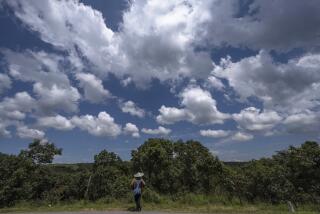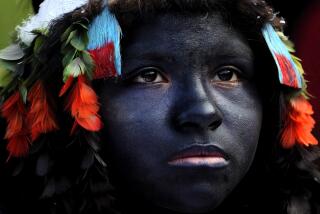Sri Lanka’s Aborigines Fight Inroads That Threaten Their Traditional Way of Life
- Share via
MAHIYANGANA, Sri Lanka — When a generous but ill-informed well-wisher gave Sri Lanka’s aboriginal chief a television set, he promptly donated it to the local school.
“Why should we watch television when we can see things happening in real life in the jungle?” asked Tissahamy, leader of a dwindling tribe of aborigines, known as Veddhas.
Tucked away in a wildlife sanctuary in the north central province, the Veddhas are demanding their own land, where they can hunt and live as they choose.
Although the government promised them 1,500 acres encompassing five of their original villages more than a year ago, they have received nothing.
“It’s only talk,” said Tissahamy, sitting outside his small mud hut. He is old and frail, his eyesight failing. A hearing aid is his only concession to the modern world.
The government has offered to settle Veddha families who cross over to civilization in plots of irrigated land, and many have accepted. But not Tissahamy.
The chief, who says he does not know how old he is but who appears to be in his 80s, is asking for the ancestral homeland to be surveyed and a for document saying it belongs to the aborigines.
“God gave us this land. This is where I was born and this is where I will die,” Tissahamy said.
The 1,500-member Veddha clan still gathers honey and hunts deer and wild pigs in the sanctuary--despite a government ban. But they have replaced their bows and arrows with crudely crafted guns.
Four of their tribesmen have been killed by wildlife rangers.
Where once they killed only to eat, the Veddhas now trade meat for guns, gunpowder and food they do not make themselves.
“I like to go into the jungle and hunt. I don’t need to read or write,” said Tissahamy’s grandson, Sudu Bandiya, 15, who left school two years ago.
About 133 Veddha families who accepted the government’s offer of irrigated land live 35 miles away near the Mahaveli River, growing rice and other crops. They left their ancestral forest homes because the government wanted to turn the land into a lake and a wildlife sanctuary.
Population pressures and diminishing forest reserves also put an end to their nomadic cultivation.
But in May of last year, unhappy with their living conditions, several of the Veddhas threatened to march back to the jungles and give up their cultivated land.
During a hasty meeting, the minister of lands and irrigation promised to build them houses and appoint an official to look into other problems.
But they still say there is no money for fertilizer and not enough water to grow crops. Most of them have leased out their land for others to cultivate.
Living across the river from a sanctuary abundant with animals, the Veddhas continue to hunt.
“It is our way of life. Even if the president tells us not to, we will continue,” said Thapal Bandiya, as he watched bricks being laid for his new house. In the yard, deer skins were spread out to dry.
Some of the settlers’ children, all of whom have gone to school and speak Sinhalese as well as their mother tongue, work in garment factories or as laborers in nearby towns.
“I don’t know about the future generations, but I prefer to live in the jungles,” said Bandiya, who wears a loincloth, leaves his hair and beard uncut and hunts with a bow and arrow.
He has taught his children and grandchildren how to hunt, collect honey and speak their language.
Some, though, are reluctant forest dwellers. “I don’t want to go to the jungles. I prefer to work in the fields,” said 17-year-old Wimala Tissa. “If necessary, I will even leave the village and look for work outside.”
More to Read
Sign up for Essential California
The most important California stories and recommendations in your inbox every morning.
You may occasionally receive promotional content from the Los Angeles Times.










